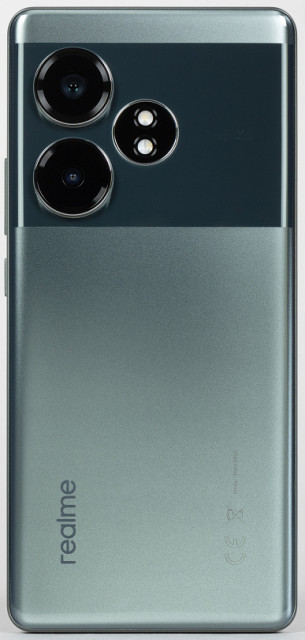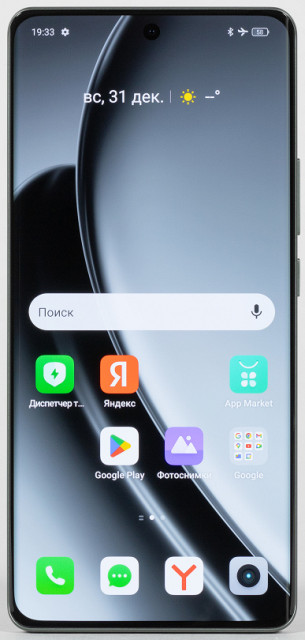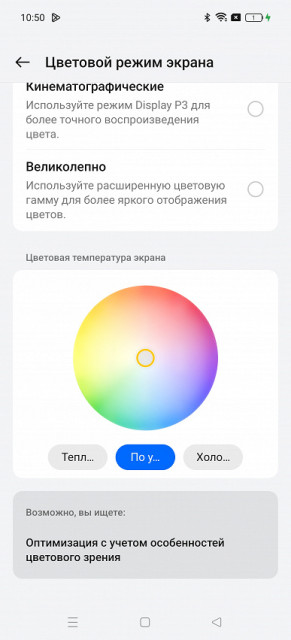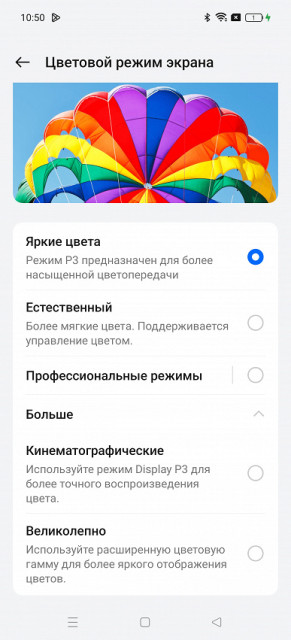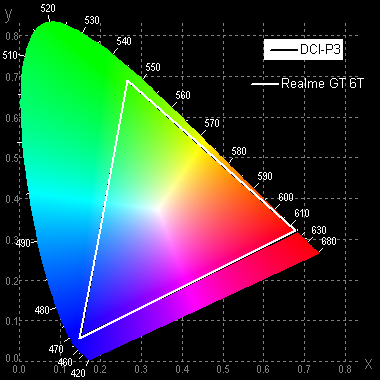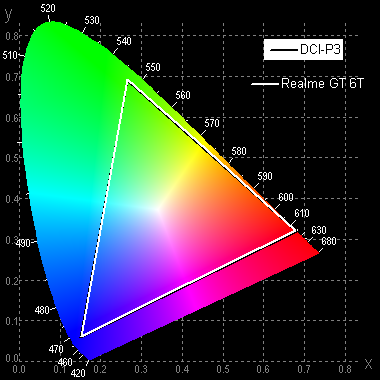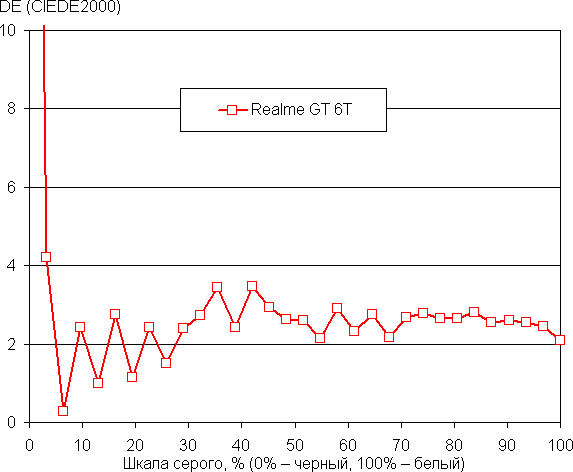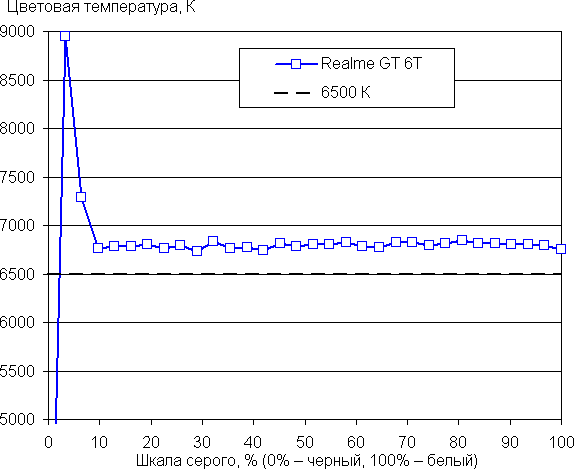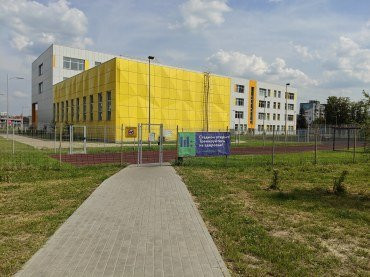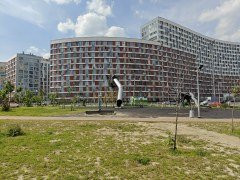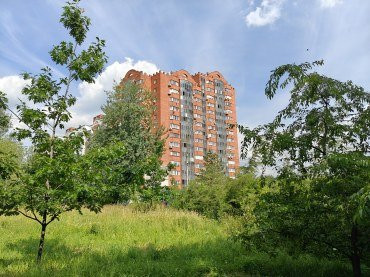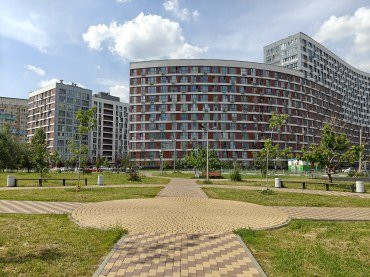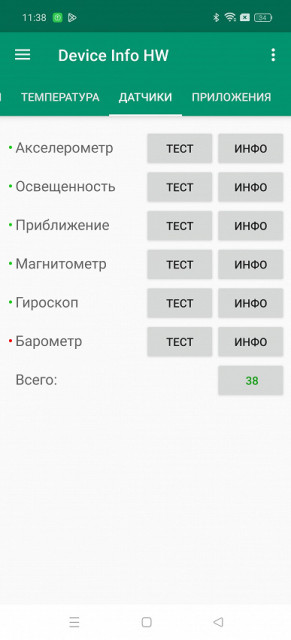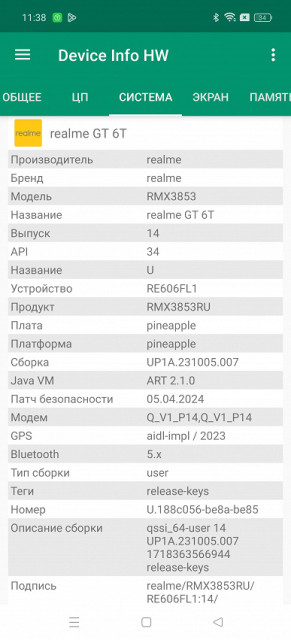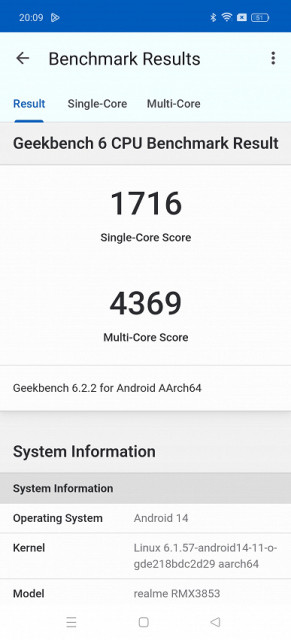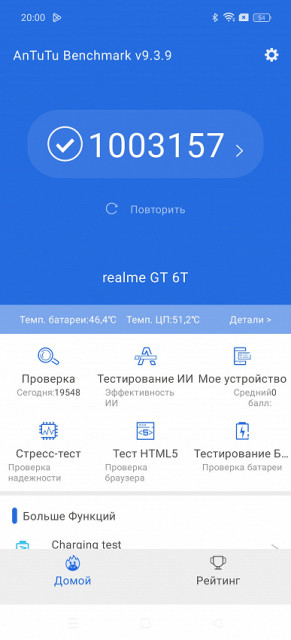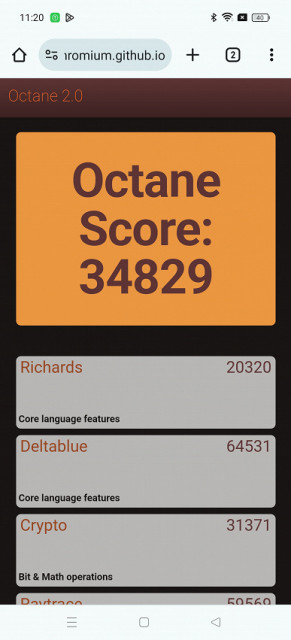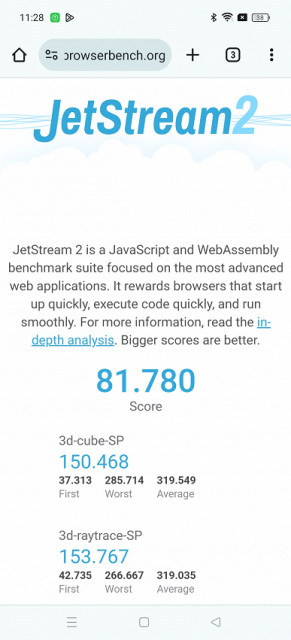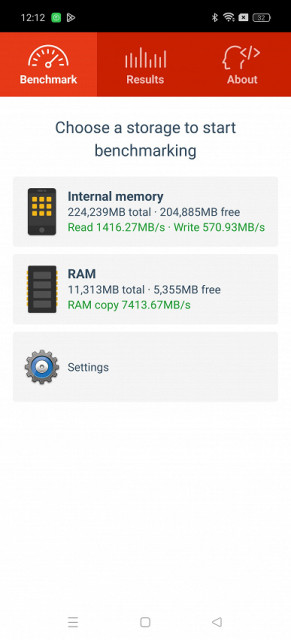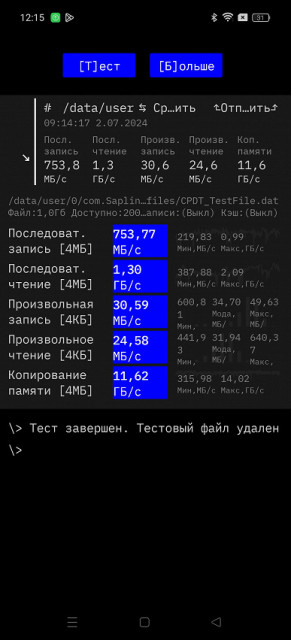Realme GT 6T is a new member of the powerful GT smartphone line. This smartphone offers a balanced combination of price and performance for those who are looking for a quality option, not ready to overpay for the flagship Realme GT 6 model, but do not want to sacrifice comfort and high performance. Will this model become a worthy representative of its segment?
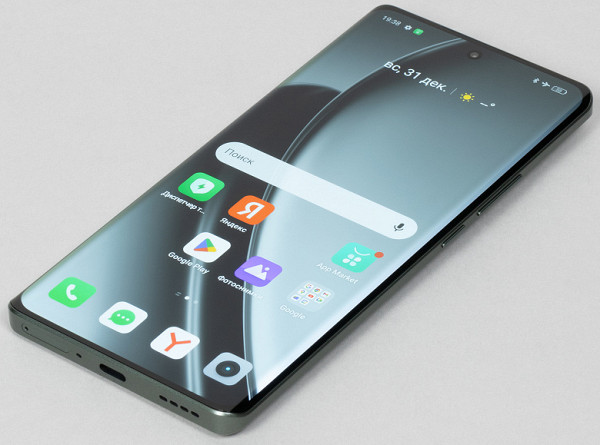
Key Features of Realme GT 6T (Model RMX3853)
- SoC Qualcomm Snapdragon 7+ Gen3, 8 processor cores (1×Cortex-X4 @2800 MHz + 4×Cortex-A720 @2600 MHz + 3×Cortex-A520 @1900 MHz)
- GPU Adreno 732
- OS Android 14, Realme UI 5.0
- Touchscreen AMOLED, 6.78″, 1264×2780, 20:9, 450 ppi, 120 Hz
- RAM 8/12 GB, internal memory 256/512 GB
- No microSD support
- Nano-SIM support (2 pcs.)
- Networks 2G GSM, 3G WCDMA, 4G LTE, 5G
- GPS, GLONASS, BDS, Galileo
- Wi-Fi 6 (2.4 and 5 GHz)
- Bluetooth 5.4
- NFC
- IR port
- USB 2.0 Type-C, USB OTG
- no 3.5 mm audio output for headphones
- Cameras 50 MP + 8 MP (wide-angle), video 4K@60 fps
- Front camera 32 MP
- Proximity and light sensors, magnetic field, accelerometer, gyroscope
- Fingerprint scanner (under the screen)
- Battery 5500 mAh, charging 120 W
- Dimensions 162×75×8.7 mm
- Weight 191 g
Appearance and ease of use
The Realme GT 6T smartphone comes in a hard cardboard box with a discreet, laconic design.
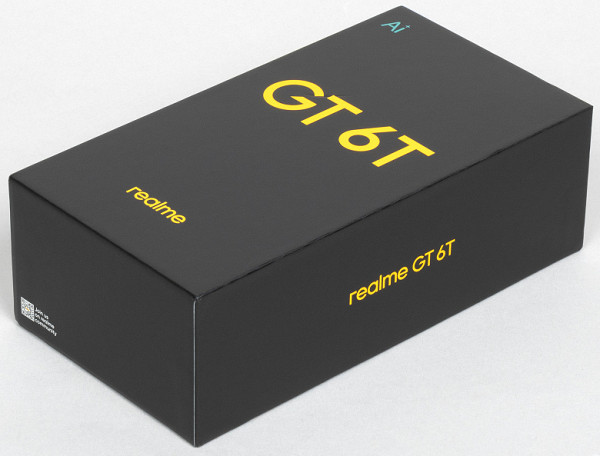
The kit includes a 120W power supply, a connecting cable and a protective case.
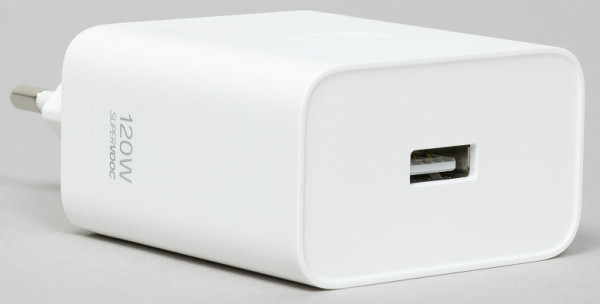
The Realme GT 6T body has a streamlined design with curved front and back panels and tapered sides. Instead of rounded sides, they have a flat surface, which makes the device comfortable to hold in your hand. Although the side frame is not metal, it is made in a matte finish, which makes it less slippery.
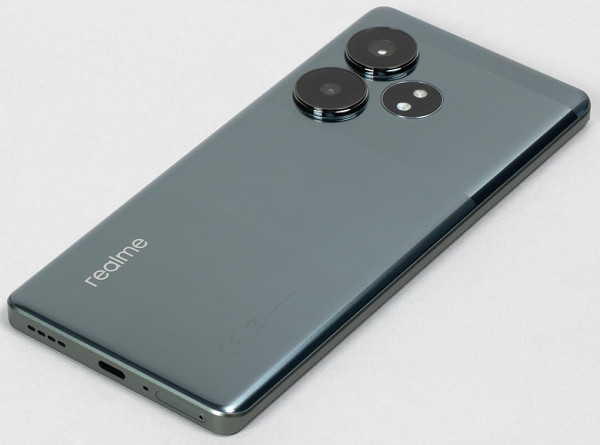
The phone looks elegant and expensive, despite the fact that the materials used are not premium. However, given the current price of the smartphone, one would expect a real metal frame.

The manufacturer does not disclose what the back panel is made of — it looks like smooth glass or plastic. The front glass, however, is clearly identified: it is scratch-resistant Corning Gorilla Glass Victus 2 with rounded edges.
The cameras are very elegantly designed. Instead of bulky connecting blocks, there are simply two round elements with lenses and one additional one for the flash. Although the dimensions of these round elements are noticeably larger than the diameter of the lenses, which allows for optimization, the overall design looks elegant and lightweight.
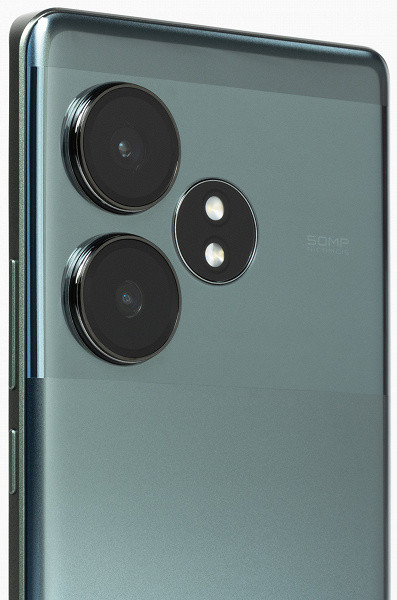
The protruding cameras lift the phone when it's placed on a hard surface, which can make the screen feel unsteady when using it. However, the angled placement of the cameras prevents your fingers from blocking them when taking pictures, which is a more important benefit.

The included case raises questions. Although it looks more expensive than the usual transparent silicone case, its opacity completely hides the design of the case that the designers worked on.
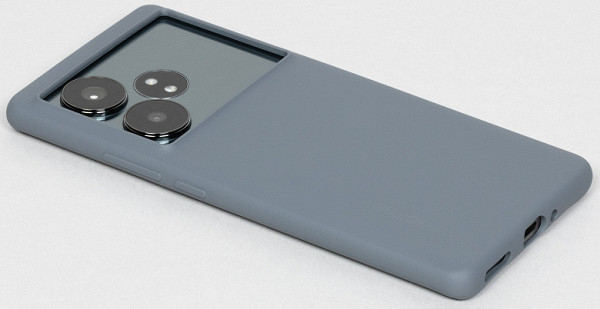
The side buttons themselves are very thin, but at least they are located on one side, right under the finger. The action of the buttons is quite elastic.

A single front camera eye is installed behind a round cutout in the screen matrix in the center of the top edge
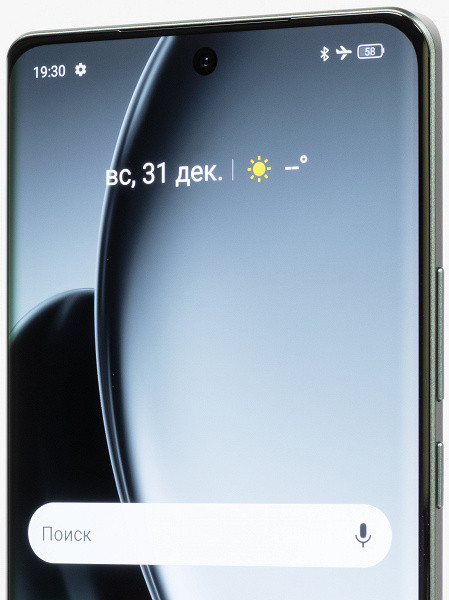
The fingerprint scanner is located under the bottom of the screen glass. The sensor is optical, located low, this solution is less convenient and less fast than the scanner in the side button.

The tray on the bottom edge can accommodate two Nano-SIM cards (on one side and the other side of the sled). There is no provision for installing a microSD memory card.
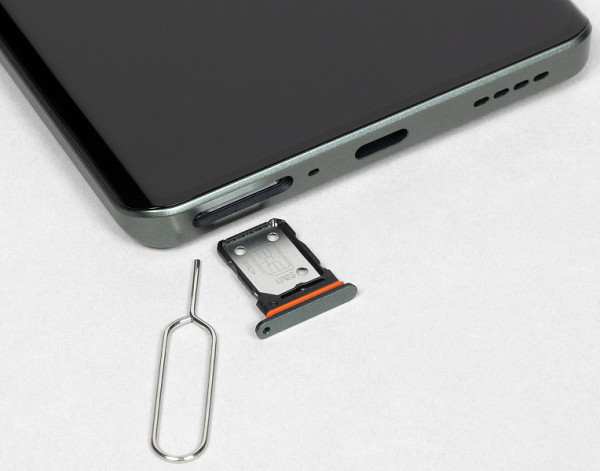
Here, on the bottom end, there is a speaker, microphone and USB Type-C connector.

The top end is dedicated to an additional microphone, a second speaker for stereo sound and an IR transmitter.

Realme GT 6T is available in two main colors — green and silver. The body is protected from moisture and dust according to the IP65 standard.
Screen
The Realme GT 6T smartphone features a 6.78-inch AMOLED display with a resolution of 1264 x 2780 pixels (aspect ratio 20:9), which is protected by glass with curved edges. The screen dimensions are 71 x 157 mm, and the pixel density is 450 ppi. The frame around the screen is 1 mm wide on the sides and 2 mm at the top and bottom. The screen supports a refresh rate of 120 Hz.
The front surface of the Realme GT 6T display is made of a glass plate with a mirror-smooth surface that is resistant to scratches. The anti-glare properties of the screen are slightly better than those of the Google Nexus 7 (2013), and the oleophobic coating effectively repels grease, which makes it easier to remove fingerprints and slows down their appearance compared to ordinary glass.
The maximum screen brightness is about 940 cd / m² with manual control, and can increase to 1530 cd / m² in bright external lighting. At the same time, the smaller the white area on the screen, the brighter the display. The minimum screen brightness is 1.6 cd / m², which allows you to comfortably use it in complete darkness. The screen is equipped with automatic brightness control using the light sensor, which is located under the screen, to the right of the camera. In automatic mode, the brightness changes depending on the external conditions: in complete darkness it decreases to 1.6 cd/m², in office lighting (approximately 550 lux) it is set to 140 cd/m², and under direct sunlight it increases to 1530 cd/m². The auto-brightness function works adequately, allowing the user to slightly adjust the brightness to their preferences.
At high and medium brightness levels, modulation with a frequency of 360 Hz is observed. The graphs below show the dependence of brightness on time for various brightness settings.

At high and medium brightness, the modulation has a low duty cycle and high frequency, which makes visible flickering unnoticeable. At a significant decrease in brightness, modulation is also present, but at a high frequency (2160 Hz), so visible flickering is still absent.
A mode with an increased refresh rate of up to 120 Hz is available in the display settings, and you can set your own maximum refresh rate for individual applications.
In 120Hz mode, the smoothness of scrolling menu lists is significantly improved, while the modulation pattern remains unchanged. Note that in the absence of screen touches, the refresh rate can be reduced to 1Hz regardless of the selected mode.
There is also a One-pulse EM mode function, designed to reduce flickering (although it is not noticeable anyway) at high and medium brightness.
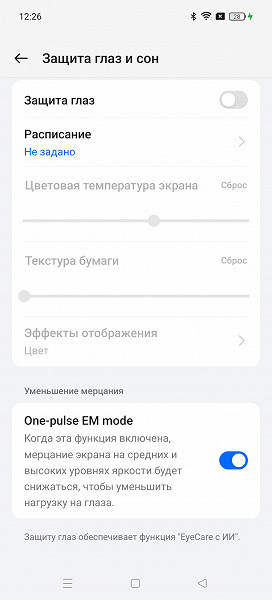
Let's turn it on and see what happens to the modulation character:

At high and medium brightness, the modulation frequency has dropped to 120 Hz. It is not entirely clear to us how this can reduce the visibility of flickering.
The display uses a Super AMOLED matrix — an active matrix on organic light-emitting diodes. The full-color image is formed using subpixels of three colors: red ®, green (G) and blue (B), while there are twice as few red and blue subpixels, which corresponds to the RGBG scheme. This is confirmed by a fragment of a microphotograph.
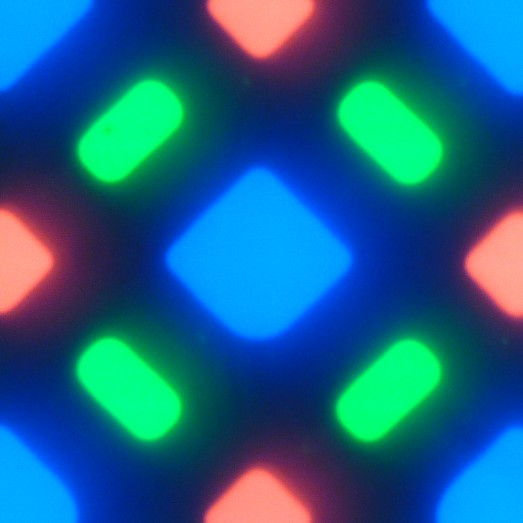
The fragment shows 4 green subpixels, 2 red (in the form of 4 halves) and 2 blue (1 whole and 4 quarters). These fragments can be repeated across the entire screen without gaps or overlaps. Such matrices are called PenTile RGBG by Samsung. The screen resolution is calculated by green subpixels, which means that the resolution will be lower for red and blue. Although this may lead to some unevenness of contrast borders and other artifacts, due to the high resolution, their impact on image quality is minimal.
The screen demonstrates excellent viewing angles. The brightness at an angle for both screens decreases compared to the Nexus 7, but for the smartphone this decrease is less noticeable. Even with the same brightness settings, the smartphone screen looks significantly brighter, since it is often viewed at an angle. However, at large angles of deviation, white can acquire a barely noticeable blue-green tint, while black remains rich black at any angle. This makes the contrast parameter inapplicable. For comparison, photos of the screens of a smartphone and another device with identical images are provided. The brightness of the screens is set to approximately 200 cd/m², and the color balance on the camera is set to 6500 K.
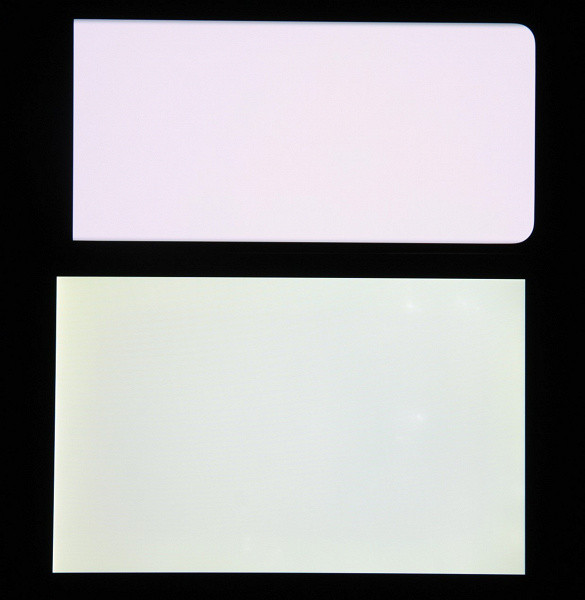

The colors on the smartphone screen look oversaturated (for example, tomatoes, bananas, napkins and face color), and the color balance is noticeably different. It should be noted that the photo cannot accurately reflect the quality of color rendering and is used only for conditional visual illustration. In particular, the reddish tint of the white and gray fields, which is noticeable in the photos, is visually absent when viewed perpendicularly, which is confirmed by hardware tests using a spectrophotometer. This is due to the fact that the spectral sensitivity of the camera matrix does not coincide with the characteristics of human vision.
Please note that the picture occupies the entire height of the screen (in landscape orientation), going to the curved edges, which leads to slight darkening and color distortion. These areas also often glare in the light, which complicates viewing images. Even videos with an aspect ratio of 16:9 go to the bends of the screen, which interferes with viewing.
The photo was taken using the «Vivid colors» profile, installed by default. There are four profiles available:
When you select the Cinematic profile, the color saturation is the same, but the color balance changes — the shades become warmer:

In the case of the Superb profile, the color saturation is higher than in the case of the Vivid profile, and the color contrast is slightly increased:
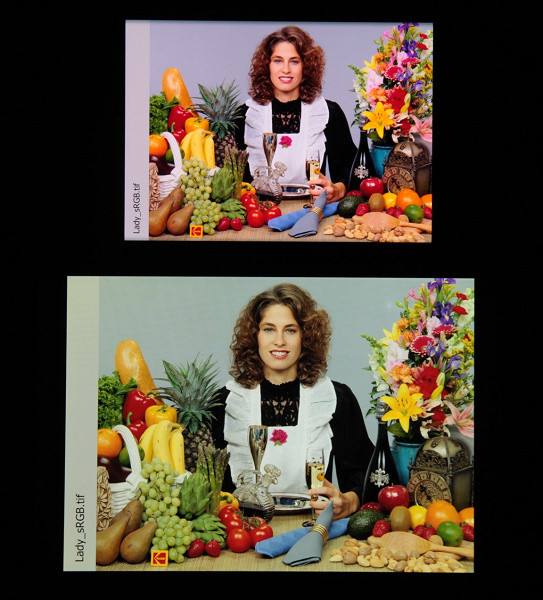
Whereas in the case of the Natural profile the situation is better:
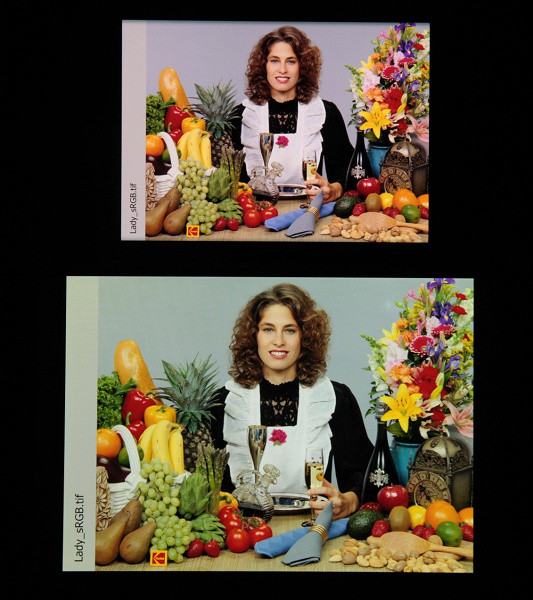
The color saturation is within the normal range, there is no increase in color contrast, and the color balance is close to standard.
Switching of the matrix elements state occurs almost instantly, however, at the switching front a step of about 17 ms wide (corresponding to a screen refresh rate of about 60 Hz) or about 8 ms (120 Hz) can be seen. An example is the graph of the dependence of brightness on time when switching from black to white in 60 Hz and 120 Hz modes:
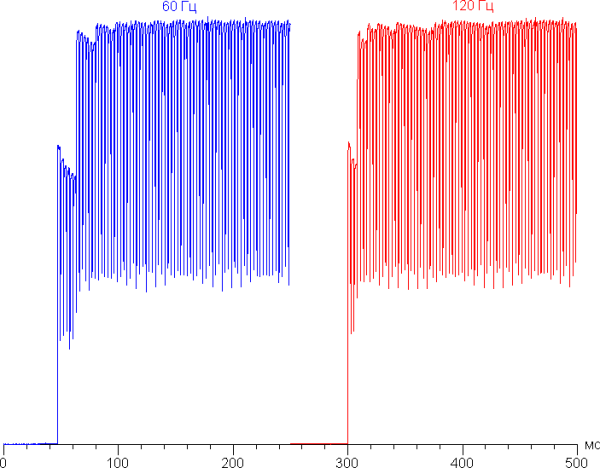
In some conditions, such a step can cause trails that follow moving objects.
The results of constructing a gamma curve based on 32 equally spaced grayscale points show no significant distortions in either light or dark areas. The exponent of the approximating power function is 2.21, which is close to the standard value of 2.2. The actual gamma curve barely deviates from the power law:

It should be noted that on OLED screens, the image brightness changes dynamically depending on the image content, which leads to a decrease in brightness for bright areas. Therefore, the dependence of brightness on hue (gamma curve) may not accurately reflect the gamma of a static image, since measurements were taken with sequential display of gray shades over almost the entire screen area.
The color gamut in the «Vivid colors» and «Cinematic» modes exceeds sRGB and is close to DCI-P3.
In the case of the Magnificent profile, the reach is even wider:
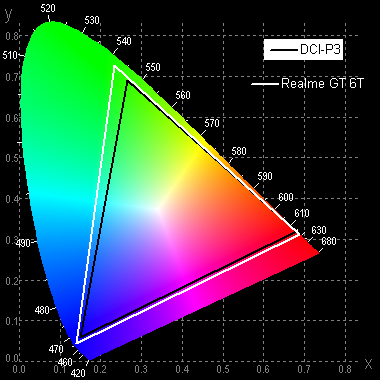
When you select the Natural gamut profile, it is compressed to the sRGB limits:
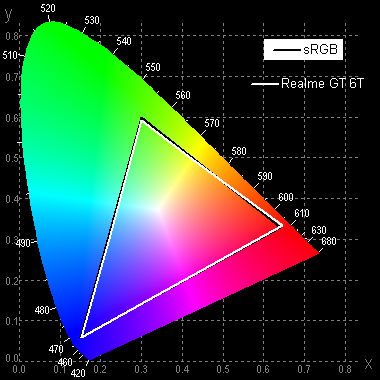
In the case of the Excellent profile, the component spectra are very well separated, which allows for wide coverage:
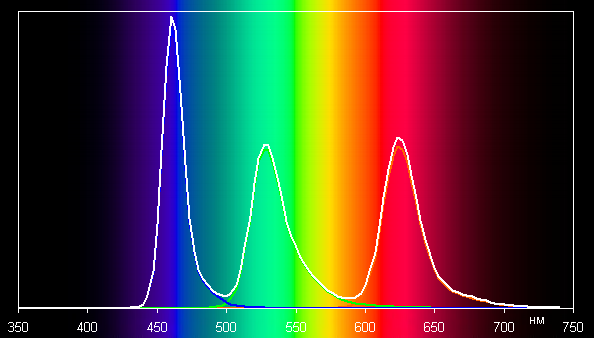
In the case of the Natural profile with maximum coverage correction, the color components are mixed with each other to a significant extent:
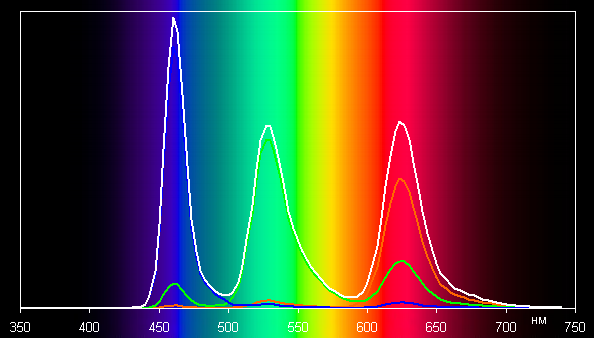
On wide-gamut displays, images not adjusted for sRGB may appear oversaturated. Therefore, the Natural profile is recommended for viewing movies, photos, and other natural images. The Vivid and Cinematic profiles are better suited for content with a DCI-P3 coverage, which is used in digital cinema but is less common in everyday life.
After selecting the Natural profile, the balance of shades on the gray scale becomes very good: the color temperature is close to the standard 6500 K, and it remains stable over a significant part of the scale, which improves the visual perception of colors. The deviation from the spectrum of an absolute black body (ΔE) is below 10 units, which is acceptable for consumer devices, and the spread of this characteristic is also small.
(The darkest parts of the gray scale can usually be ignored, since the color balance in these areas is not so important, and the measurement error at low brightness can be high.)
The device provides options for adjusting the color balance: you can select a color temperature profile or adjust the hue on the color wheel. However, choosing the «Natural» profile already provides good quality. You can also reduce the intensity of the blue component in the settings, although this is usually not necessary. Bright light can disrupt the daily (circadian) rhythm, as described in the article about the iPad Pro with a 9.7-inch display, but this can be corrected by reducing the brightness to a comfortable level, without having to distort the color balance by reducing blue.
There is a function called «Natural Color Mode» (REO), which adjusts the color balance depending on environmental conditions. We turned this function on and tested its work with the «Vivid Colors» profile:
| Terms and Conditions | Color temperature on a white field, K | ΔE on a white field |
|---|---|---|
| REO function is disabled | 7900 | 1,1 |
| REO included, LED lights with cool white light (6800K) | 6000 | 0.8 |
| REO is on, halogen incandescent lamp (warm light — 2850 K) | 5500 | 1.3 |
When lighting conditions change significantly, the color balance correction is weak, so the Natural Color Mode function does not always work as expected. Currently, the standard is to calibrate display devices to a white point of 6500 K. However, correction for the color temperature of external light can be useful to more accurately match the image on the screen to what is visible on paper or other reflective media.
The device probably does not support DisplayPort Alt Mode for USB Type-C, which means that there is no way to output image and sound to an external device via this port.
To summarize: the device's screen has a very high maximum brightness of up to 1530 cd / m² and excellent anti-glare properties, which makes it convenient for outdoor use on a sunny day. In complete darkness, the brightness can be reduced to a comfortable level (up to 1.6 cd / m²). The automatic brightness adjustment mode works adequately. The advantages of the screen include an effective oleophobic coating, no visible flickering, high resolution, a 120Hz refresh rate mode, a color gamut close to sRGB, and good color balance when the profile is selected correctly. The OLED screen provides true black (without reflections), excellent white field uniformity, and a significantly smaller drop in brightness when viewed at an angle compared to LCD displays. However, the curved edges of the screen can distort the color tone and reduce brightness at the edges, as well as create glare in external lighting. Overall, the quality of the screen is high.
Camera
The Realme GT 6T smartphone is equipped with the following cameras:
- Main: 50 MP, 1 / 1.95 ", f / 1.9, 26 mm, PDAF, OIS
- Wide-angle: 8 MP, 1 / 4.0 ", 1.12 µm, f / 2.2, 16 mm, 112˚ field of view
- Front: 32 MP, 1 / 2.74 ", f / 2.5, 21 mm
The main camera takes photos at 12.5 MP by default thanks to 4-in-1 pixel binning, but you can also shoot at full 50 MP. Photos at 50 MP show improved detail, although the differences in image quality (not taking into account the file size) are small. Image processing to reduce their size is done carefully, with a moderate increase in exposure.
The quality of the photos on the Realme GT 6T smartphone is at a good average level and often even higher, although it does not reach flagship standards. The camera provides high detail, sufficient dynamic range, preventing overexposure and dips in the shadows. The optics work cleanly, without smears, and the contour sharpness is at the proper level. The advantages include good contrast, which makes the photos bright and voluminous, and the color rendition is quite natural.
Here are additional examples of photos taken with the main camera in auto mode:
Night shots on the Realme GT 6T show balanced results at best in the fight against noise. Light areas are rendered very well, and the exposure is almost perfect. The pictures remain clear and not overexposed, preserving the nighttime atmosphere.

There is no separate zoom lens here, as in flagship models, so you have to use digital zoom. The camera uses a crop of a full-size photo, which provides some increase in detail, but this is accompanied by a significant increase in contour sharpness. As a result, viewing such photos at a scale of 1:1 may not be very pleasant. The maximum magnification is 20×.
The wide-angle module delivers excellent image quality in the center of the frame, and the edges are blurred moderately and smoothly. This camera is quite usable in practice, although it is, of course, better to use the main camera when possible.
The smartphone supports 4K video recording at 60 frames per second, which corresponds to a high sub-flagship level. The video is bright, contrasting and saturated. Image detail is high, and electronic stabilization works effectively. Sound recording is also of high quality.
Telephone and communications
The Realme GT 6T smartphone supports most mobile networks up to 5G, two Wi-Fi 6 and Bluetooth 5.4 bands, as well as NFC. However, e-SIM is not supported. Within the Moscow region, the device works confidently in wireless networks, does not lose connection and quickly restores it after interruptions. All the necessary sensors, including a gyroscope, are present.
The satellite navigation module supports GPS, GLONASS, BDS, Galileo and QZSS. Satellites are detected quickly even with a cold start, and the positioning accuracy is good.
The speaker is loud enough, the voice of the interlocutor is clear. The vibration call is pleasant and well felt.
Software and multimedia
The smartphone runs on Android 14 OS with the proprietary Realme UI 5.0 shell. The interface functions stably and is optimized, but recently it has increasingly become filled with unnecessary pre-installed applications and ads from its own app store.
The notification shade is presented as a single element, which is a plus. Access to Google Play and Google services is fully preserved.
The smartphone's stereo speakers provide loud sound, but with insufficient saturation; high frequencies prevail.
Performance
The Realme GT 6T smartphone is equipped with an eight-core Qualcomm Snapdragon 7+ Gen3 processor and an Adreno 732 graphics chip. The RAM is available in 8 or 12 GB, and the built-in storage is 256 or 512 GB. There is no option to install a memory card, but it supports connecting external devices via USB Type-C in USB OTG mode.
The processor demonstrates excellent sub-flagship performance, is manufactured using 4-nanometer technology and scores over a million points in AnTuTu. Despite the noticeable level of throttling, the device easily handles video recording in 4K at 60 fps. In general, its power is sufficient to perform any tasks, including the most demanding games.
Testing in complex tests AnTuTu and GeekBench:
We have compiled the smartphone's test results in the latest versions of popular benchmarks into convenient tables. The tables also include data from several other devices from different segments, tested on the same benchmark versions for a visual assessment. Unfortunately, due to comparison limitations, it is impossible to include results from different benchmark versions, so many worthy and current models that were tested on older versions are left out of this comparison.
| Realme GT 6T (Qualcomm Snapdragon 7+ Gen3) | Oppo Reno11 5G (MediaTek Dimensity 7050) | Vivo V30e (Qualcomm Snapdragon 6 Gen1) | Huawei nova 12s (Qualcomm Snapdragon 778G) | Redmi Note 13 Pro+ (Mediatek Dimensity 7200 Ultra) | |
|---|---|---|---|---|---|
| AnTuTu (v9.x) (bigger is better) | 1003157 | 509328 | 489575 | 546957 | 669583 |
| GeekBench 6 (bigger is better) | 1716/4369 | 1091/2571 | 939/2871 | 996/2453 | 1126/2643 |
Testing the graphics subsystem in GFXBenchmark gaming tests:
| Realme GT 6T (Qualcomm Snapdragon 7+ Gen3) | Oppo Reno11 5G (MediaTek Dimensity 7050) | Vivo V30e (Qualcomm Snapdragon 6 Gen1) | Huawei nova 12s (Qualcomm Snapdragon 778G) | Redmi Note 13 Pro+ (Mediatek Dimensity 7200 Ultra) | |
|---|---|---|---|---|---|
| GFXBenchmark Aztec Ruins OpenGL (Onscreen, fps) | 117 | 30 | 29 | 34 | 50 |
| GFXBenchmark Aztec Ruins Vulkan (Onscreen, fps) | 129 | 26 | 31 | 38 | 55 |
| GFXBenchmark Car Chase ES 3.1 (1080p Offscreen, fps) | 94 | 26 | 24 | 33 | 43 |
| GFXBenchmark Manhattan ES 3.1 (1080p Offscreen, fps) | 163 | 45 | 45 | 56 | 74 |
| GFXBenchmark T-Rex (1080p Offscreen, fps) | 400 | 106 | 106 | 133 | 191 |
Testing in browser cross-platform tests:
| Realme GT 6T (Qualcomm Snapdragon 7+ Gen3) | Oppo Reno11 5G (MediaTek Dimensity 7050) | Vivo V30e (Qualcomm Snapdragon 6 Gen1) | Huawei nova 12s (Qualcomm Snapdragon 778G) | Redmi Note 13 Pro+ (Mediatek Dimensity 7200 Ultra) | |
|---|---|---|---|---|---|
| Google Octane 2 (bigger is better) | 34829 | 7118 | 33442 | 24923 | 39276 |
| JetStream (bigger is better) | 82 | 29 | 93 | 67 | 79 |
Memory speed test results:
Heat
We test for performance degradation when heating using the Burnout Benchmark program, which allows you to load the CPU, GPU and NPU:
| Load on | Heating performance, as a percentage of maximum |
|---|---|
| CPU | 36% |
| GPU | 61% |
| NPU | 30% |
Battery life
The Realme GT 6T smartphone is equipped with a 5500 mAh battery and shows excellent battery life.
The testing was carried out at a normal power consumption level, without turning on the power saving functions that are present in the device. The minimum comfortable brightness level (about 100 cd / m²) was used for testing. The tests included: endless reading in Moon + Reader (with the standard light theme), continuous viewing of HD video (720p), and the game Injustice 2 with automatic graphics settings.
| Battery capacity | Reading mode | Video mode | 3D gaming mode | |
|---|---|---|---|---|
| Realme GT 6T | 5500 mAh | 32 h 00 m | 29 h 00 m | 8:00 a.m. |
| Realme GT 6 | 5500 mAh | 32 h 00 m | 27:00 | 9:00 a.m. |
| Oppo Reno11 5G | 5000 mAh | 27:00 | 25:00 p.m. | 8:00 a.m. |
| Vivo V30e | 5500 mAh | 29 h 00 m | 26 h 00 m | 8:00 a.m. |
| Infinix Note 40 | 5000 mAh | 18:30 | 15:00 | 6 h 30 min |
| Tecno Spark 20 Pro+ | 5000 mAh | 18:00 | 14:00 | 6:00 a.m. |
| Vivo V30 | 5000 mAh | 23:00 | 21:00 | 8:00 a.m. |
| Vivo V29 | 4600 mAh | 21:00 | 19:00 | 8 h 30 min |
| Infinix GT 10 Pro | 5000 mAh | 20:30 h. | 18:00 | 8 h 30 min |
The Realme GT 6T smartphone is equipped with a 5500 mAh battery and shows excellent battery life.
The testing was carried out at a normal power consumption level, without turning on the power saving functions that are present in the device. The minimum comfortable brightness level (about 100 cd / m²) was used for testing. The tests included: endless reading in Moon + Reader (with the standard light theme), continuous viewing of HD video (720p), and the game Injustice 2 with automatic graphics settings.
Results
The Realme GT 6T smartphone costs between $605 and $660 depending on the memory configuration, which is in line with the prices of full-fledged sub-flagship devices. Although it is not a budget option, the Realme GT 6T justifies its price, unlike the older Realme GT 6 model, which does not quite live up to the declared title of “flagship killer”.
This smartphone has an excellent Qualcomm hardware platform, providing excellent photo quality, support for 4K@60 fps video recording and outstanding battery life. Combined with an excellent AMOLED screen and a stylish design, the Realme GT 6T is a very attractive choice.

